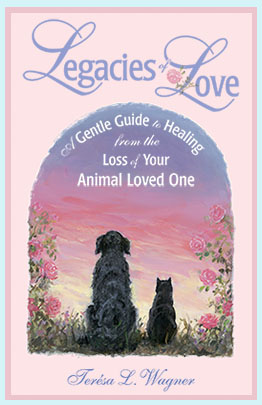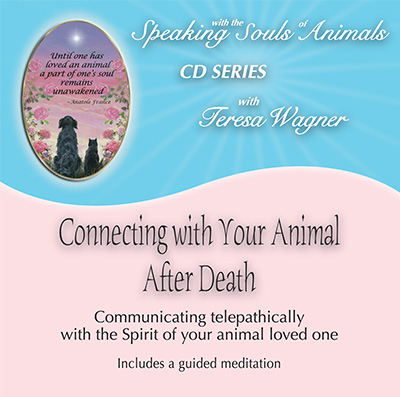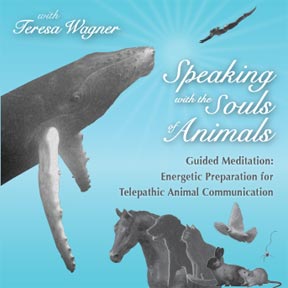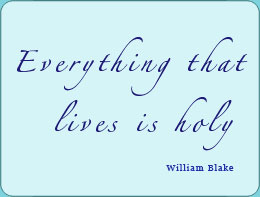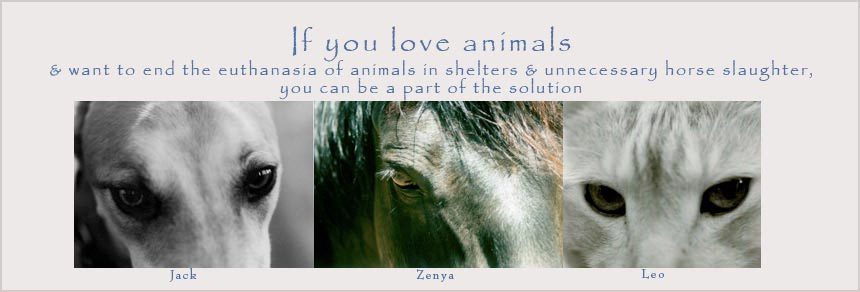When Animals are in Harm's Way
text copyright Teresa Wagner
photos copyright Aquatic Adventures/Adele Frogon
Can you imagine seeing a four week old humpback calf with fishing lines one and one- half inch thick deeply embedded into his flesh? Can you imagine seeing this little whale dragging 150 feet of fishing line with two desk size fishing traps at the end? Can you imagine hearing him wheezing because he’s so ill he cannot breathe properly? Can you imagine being a humpback calf and not be able to dive because the ropes entangled around your fluke and the weight of the traps dragging behind you make it impossible to move your body normally? Can you imagine being the mother of this calf, unable to nurse or even touch him because you would become entangled too? Can you imagine watching your offspring slowly die and not be able to do a thing about it?
Can you imagine seeing an adult humpback so emaciated it’s hard to believe he is still alive? And that he is so completely covered in whale lice that his skin looks more like a right whale covered with callosities rather than a sleek black humpback? Can you imagine seeing fishing ropes embedded around his head and through his mouth and realizing the reason he may be so emaciated is that he cannot open his mouth to eat? Can you imagine being a humpback whale and not being able to move one of your pectoral fins because thick fishing rope is embedded several inches into your skin where your pec meets the side of your body and it’s too painful to move it? Can you imagine wanting help but being wary and perhaps terribly frightened of the humans approaching you with all sorts of tools?
Of course, the brave members of disentanglement teams around the world have seen such horrors many times. It’s what they do. They are heroes to the whales and to all of us who love whales. People on “pleasure” whale watching trips, however, don’t expect to see entangled whales. But it happens.
I’ve been taking groups of people on humpback whale swim trips to Silver Bank since 1999. From the beginning, I knew I could not participate in any activities that would serve only the humans or disturb the whales. Thanks to the soft-in-water encounter guidelines that all operators in the Silver Bank Marine Mammal Sanctuary of the Dominican Republic1 must follow, there is no disruption of the whales’ natural behavior. They come to us if they want to. When they don’t, well then they don’t. We do not chase them. When they approach and stay close to us, the joy and bliss from such encounters is inevitable. It’s why so many people keep coming back to these trips. It’s enthralling and sometimes even life changing. But what do the whales get? Given that the whales we are with intentionally approach us, and choose the proximity and length of encounters, it seems clear that at the very least they are curious about us and, I believe, also enjoy and take in the love and the sacred respect we offer them. But loving them, however respectfully and sacredly, is not enough. It’s not enough to just love the whales and to feel graced by their mere presence. Whales are in peril. It has been estimated that over 300,000 cetaceans die each year worldwide as a result of entanglements (Reid et al, 2006).2 They need help and we owe it to them to find ways to give it.
To be sure that the participants on my trips understand the threats to whales and what we can do about them, I provide in depth presentations on the natural history of humpbacks and specific threats to their survival and well being, including detailed information on entanglement and disentanglement. I’ve been closely following whale entanglement issues and disentanglement incidents since 1988 after I saw a whale for the first time and fell in love with them. It’s one thing to know the facts about whale entanglement--to read articles, watch videos, view photographs of incidents and teach classes about it--it’s quite another to see it live. The horror of it is nightmarish. The ‘can you imagine’ scenarios above are not imaginary. I saw them.
On a Sunday afternoon, February 12, 2012, I was standing at the stern of the dive boat Turks and Caicos Explorer II, moored in Silver Bank, happily waiting for our captain Tom Conlin of Aquatic Adventures3 to bring a tender to the side of the boat for our first whale excursion of a week at sea. Much to my excitement, initially joyful excitement, a lone humpback began swimming directly toward the spot where I stood. As he got closer to the boat I could see that he was grossly entangled in fishing gear. Ropes and buoys crisscrossed his body--through his mouth and dragging from his body. His dorsal fin was limp, completely flopped over. There were large patches of raw skin on his body, and what appeared to be embedded ropes through his flesh. It was also alarming to see how emaciated he was, and how his body was covered in whale lice. Had I not known better, I would have thought an abnormally thin right whale made it’s way to Silver Bank. He was in terrible physical shape and barely looked like a humpback.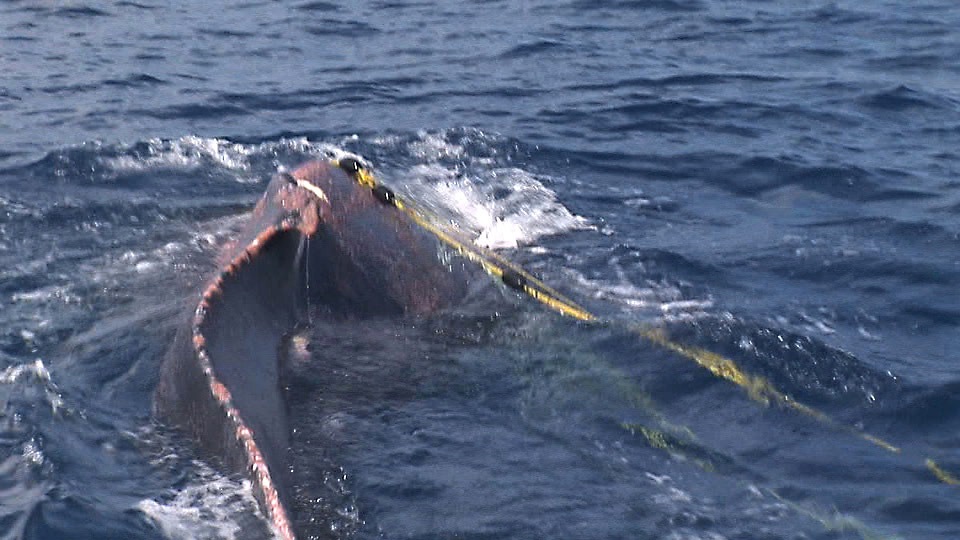

I immediately ran to the port side of the boat where Tom was bringing in his tender alerting him that we had an entangled whale at the stern. We quickly boarded the tender and several hours of disentanglement work began. The following are excerpts from Tom’s report of the incident.4
As we were trying to follow him I noticed a very long, heavy line he was dragging behind him. I donned my scuba tank, prepared my mask, fins and snorkel and unsheathed my six-inch knife. My second attempt to grab the line behind the whale was successful. I slowly pulled myself up the line and started cutting the lines and net about ten feet behind the fluke. Looking at the whale from this angle it seemed as though he only had one pectoral fin, but actually he was holding his right pectoral fin tight against his body to prevent the line from gauging any deeper into the joint area under his pectoral fin.
The lines were a series of two sets of two different sizes of polypropylene lines, three in total in each set. Each set had an additional two lead-filled braided nylon lines with small floats every one and a half feet run through the polypropylene. Both sets of five lines were connected by a monofilament net.
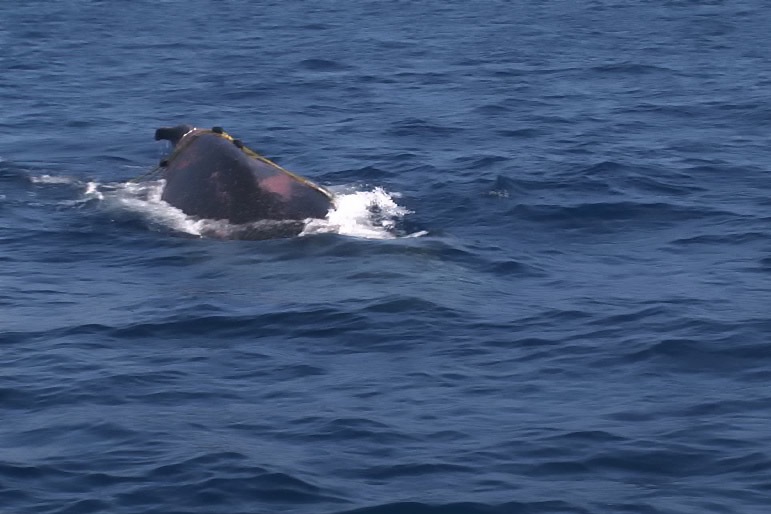
An amazing thing happened after the heavy ninety-plus-foot line was free from the whale. He settled, and started to lie still on the surface. Actually, coming to me, very calm, but obviously in pain. By now, Jeff from Conscious Breath Adventures5 was in the water to assist in removing the remaining lines. The whale still had a set of lines running across its back and over his dorsal fin. Attempting to cut these off was difficult considering how close one needed to be and how long it would take due to the two lead filled lines. We tried cutting it, but when we pulled on the line it caused the whale a lot of pain and he would react by slashing its tail and moving off, slowly returning for more help. When the whale returned it moved close to Aquatic Adventures tender “Escort” and Jeff was able to hand the remaining short set of lines up to Adele Frigon and she tied the lines off to the main cleat. Luckily the line holding the large set of five lines to the whale was only the thicker polypropylene line and it broke free as the whale pulled the tender releasing the last large set of lines from the whale. The remaining lines left were smaller polypropylene lines, three lines of thirty plus feet running along the left side of the head through the corner of the mouth and back along the right side of the body running underneath its pectoral fin, boring into his joint area, with thirty plus feet of line dangling behind that side of the whale. We tried to get the whale to open his mouth by pulling the line at the same angle as the jaw line and the whale reacted by slashing his fluke and moving away quickly. Still holding the line the whale pulled me through the water until he again calmed down. Jeff then attempted to swim below the pectoral fin and pull down on the line embedded under the joint; the whale slashed the water and snapped one of Jeff’s free diving fins. Luckily, Jeff wasn’t hurt.
Gene Flipse from Conscious Breath Adventures was now in the water to assist Jeff and me. We decided it was best to attempt cutting the line between the right side of the mouth and the right pectoral fin to facilitate the possibility of releasing that line. Gene had an extremely sharp knife to be able to cut the remaining polypropylene lines really quickly. I went to get a fresh tank but after a short time both my calf muscles were cramping to the point I couldn’t kick my legs. I returned to “Escort” and sent Sten, another crew member in to assist with the disentanglement. While I was out of the water Gene, Jeff and Sten were successful in removing the lines that were entangled around the right pectoral fin. I returned to the water after taking 20 minutes to hydrate and stretch my legs, temporarily relieving the muscle cramps in my legs. Several times the whale would spy hop and twist his body around in a circle wrapping the remaining lines around its head. We needed to get the line in front of the whale and move it to the other side where it was running through the mouth at the curve of the jaw line in front of the eye. I took the line and was able to unwrap it from his head moving the line to the side where we needed it. During this entire time frame we attempted to get him to open his mouth so we could get the last line disentangled, but to no avail. On the last attempt by one of the team he reacted and slashed his tail hitting my left thigh. At first I wasn’t sure if it was broken. I floated on the surface for a few minutes moving my leg in all directions to make sure it wasn’t. It was a good hit, but I had movement and was able to continue to help with the disentanglement. Once again we attempted to dislodge the line from its mouth and we finally decided to cut the line as close as we could to the mouth. I held the line tight and Gene cut the line leaving three pieces of line twelve to fourteen inches long. When we were through with what we considered the most we could do, the whale seemed very grateful.
It was very obvious to all of us that this whale had just arrived from its long migration from the North Atlantic. The nets appeared to be for Salmon, a Northern Atlantic catch, giving an indication of how far he dragged these lines and how long he has been entangled.
The amazing thing to me was when I cut off the bulk of the fishing line, the whale calmed down, repeatedly returning to us, actually staying still, permitting us to get very close to him to remove more lines. I have no doubt that any aggressive behavior by the whale was just a reaction caused by the pain he was tolerating while we attempted to free him from the lines. The whale was extremely fatigued, covered with whale lice and malnourished. We can only hope that he has the strength and stamina to work the remaining lines out of his mouth, heal, and migrate far enough North to start to feed again.
One thing we did learn is that we need a protocol for entanglements between the operators on the Silver Bank. Luckily Jeff and I left the water with only one broken fin and sore legs. It could have turned out much differently. The cooperation shown between all operators during this time of crises was exceptional. The only thing that mattered was helping the whale, no competitiveness, and no animosities, just love, passion and concern for the whales’ survival.
This was the second entanglement I have seen in person.The first was on March 26, 2009. I was on board a Conscious Breath Adventures tender as we began our last whale watching excursion of the week. Within minutes we encountered a four week old humpback calf torturously entangled in fishing gear. Seeing this beautiful baby whale so grossly injured from human debris was shocking. Suddenly whale entanglement was definitely more than my previous intellectual understanding of it from from statistics, stories, photos and graphics. It was real, and it was obscene. Despite Tom Conlin’s initial efforts and Jeff Pantukhoff’s hours and hours of heroic efforts to disentangle this whale, his mother was too frantic to let Jeff close enough, long enough, to complete the disentanglement. The calf died ten days later, having lived his short life in pain and fear.
Witnessing both of these entanglements changed me. My heart breaks for them and all the whales entangled in the oceans, many of whom are never even seen by humans who might help them. My heart is full of gratitude for the rescuers I witnessed risking their lives to try to save these whales, and for the men and women everywhere on disentanglement teams. But something more happened to me, something snapped inside from seeing these tragedies. I knew I could no longer just take people on pleasurable trips to be with whales, and enjoy collecting whale books, wearing fluke jewelry and adorning my house with whale art. I knew I now needed to begin speaking out for the whales more, and to stop tiptoeing around the issue of how humans literally cause whale entanglement.
Disentanglement teams are like the cardiac surgeons who save human lives. Surgeons fix the results of disease but cannot prevent it. They attempt to fix what already exists. The everyday lifestyle choices of humans hold the potential to prevent heart disease. Likewise with whale entanglement, disentanglement teams remove lethal fishing gear from whales, attempting to save one whale life at a time. As heroic as this work is, it too does not prevent or solve the problem. It helps clean up the mess, albeit a small fraction of the mess, that humans have created by littering the ocean. As with cardiac patients, it is we humans who have the power to make lifestyle choices to prevent and stop the horrific suffering of whale entanglement. All we have to do is stop eating fish.
Consumer choices dictate market demand. Remember “dolphin safe tuna?” Dolphin lovers changed an entire industry by caring enough about these animals to not eat tuna until it was caught without killing dolphins. There is, however, no “whale safe fish.” Despite the laudable efforts of NOAA-Fisheries Take Reduction Teams which include gear modification research, there is currently no fishing gear with zero potential to entangle whales. If we want to eliminate the root cause of whale suffering by entanglement we need to stop eating fish.
As heroic as disentanglement work is, and as commendable as programs are that work with fishermen to change the way lines and nets are made and used to lessen the likelihood of entanglement, neither of these activities eliminates the root cause of entanglement.
Seeing pretty pictures and reading feel good stories with happy endings for whales brings many of us great pleasure. But learning about threats to their lives--seeing the not-so-pretty pictures and reading the not-so-happy-ending stories can be disconcerting and make us uncomfortable. It requires us to have the courage to acknowledge and face, not turn away from and deny, the suffering they endure, and to examine our own conscience regarding how our behavior may be part of creating that suffering. If we love whales, we owe them both our empathy and compassion for their suffering and the guts and commitment to change something as simple as not eating fish to prevent the horrific suffering and death that entanglement brings.
All the research in the world, all the prayers in the world, all the beautiful pictures of whales in the world, all the agreements in the world with fisherman to use less lethal nets will certainly help whales, but they will not stop entanglement.
Not consuming fish is the only way we can stop it.
No matter what our roles in caring about and helping whales--scientist, researcher, executive, administrator or volunteer for an NGO, whale watch operator, artist, activist, healer, animal communicator--and no matter whether our relationship with whales is primarily intellectual, emotional, physical or spiritual, beyond the specific roles we’ve chosen to match our talents, skills and interests, if we genuinely care about the whales we have a moral responsibility to examine and change our daily lifestyle choices to reduce their suffering. Without examining and being willing to change our own behavior that harms whales, we’re complicit in their suffering. The root cause of entanglement is that humans support commercial fishing operations throughout the world by eating fish. It’s that simple. By eating fish we perpetuate entanglement.
If we know the facts about entanglement and still eat fish, what are we saying to the cetaceans we care about and study? I’m sorry you suffer but I’m used to fish as part of my diet and I don’t want to be inconvenienced to change. My body needs omega oils and I don’t want to spend time learning how I can get these elsewhere, even though they are readily available from a combination of flax oil and algae from land based sterile ponds. I love you, but not enough to give up something I think is tasty. I care about you, but hey, eating fish is an important part of my family/ethnic/cultural tradition, and doesn’t tradition trump everything? I’m sorry if my eating fish causes your species horrific suffering and death--but it’s my tradition. Holding fast to my tradition is far more important than the suffering and death it causes. I’m sorry that 300,000 of you die from fishing gear, but people make their living from fishing! People can’t be expected to change their jobs just because of your suffering and death.
It can be uncomfortable for any of us to change our diets, be it for health or ethical reasons, but we need to ask ourselves what is more uncomfortable and what causes more suffering: we as humans giving up one source of our myriad of choices for food, or thousands of cetaceans (and pinnipeds, sea birds, sharks and turtles) experiencing horrific agony and death from entanglement in fishing gear?
Humans created this suffering by our seemingly endless greed for fish and only we have the power to allow it to continue or to stop it. If we choose to eat fish, we are contributing directly to the continuing of entanglement, suffering and death of whales and other ocean animals. By choosing to not eat fish we are participating actively in preventing and ending this suffering. Our choice.
Doing nothing is not a neutral position. When we choose to avert our gaze and leave suffering unacknowledged, we implicitly support it by helping to obscure its existence.
~ Laura Smith Teachers College, Columbia University
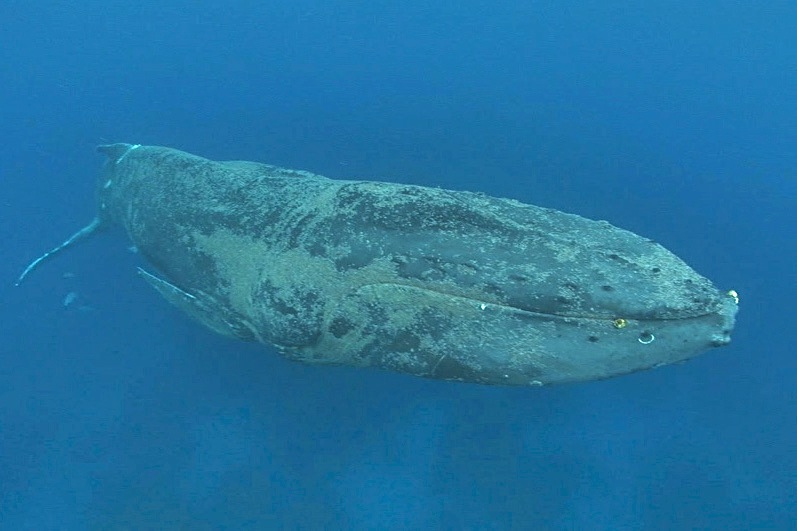
Further Resources
Tom Conlin, Aquatic Adventures
http://www.aquaticadventures.com
Over the 22 years and over 224 weeks that Tom Conin has spent on the Silver Bank with whales he has donated vessel space to some of the leading organizations and researchers in the Cetacean community such as researchers involved in YONAH (Year of the North Atlantic Humpback, a three year DNA project with researchers from 7 nations), Malcolm Clarke, David McTaggart, Greenpeace International, NOAA (National Oceanic and Atmospheric Administration), Caribbean Tagging Project (2008, 2009), Center for Coastal Studies, College of the Atlantic, Cornell University, Wheelock College, Atlantic Cetacean Research Center, Roger Payne’s Whale Conservation Society and IFAW, as well as for marine biology graduate students.
Hawaiian Islands Disentanglement Network
http://hawaiihumpbackwhale.noaa.gov/res/rescue_network.html
Marine Mammal Stranding Center (New Jersey)
http://www.marinemammalstrandingcenter.org/home.html
Whale Disentanglement in Alaska
http://www.fakr.noaa.gov/protectedresources/entanglement/whales.htm
California Central Coast Whale Entanglement Team
http://www.marinelifestudies.org/index.php/whale-entanglement-team-wet.html
Provincetown Center for Coastal Studies
http://www.coastalstudies.org/what-we-do/whale-rescue/introduction.htm
We Need to Stop Eating the Oceans, article by Paul Watson, Founder of Sea Shepherd
http://www.seashepherd.org/commentary-and-editorials/2009/04/07/we-need-to-stop-eating-the-oceans-164
Our Healing Relationship with Nature, article by Marsha Green, PhD, Ocean Mammal Institute
http://oceanmammalinst.com/ourhealingrelationship.html
The End of the Line, a powerful film about over-fishing
“The inconvenient truth about the oceans.” The Economist
http://endoftheline.com/
How Your Supplement Choices Could be Harming Whales, article by Teresa Wagner
http://www.animalsinourhearts.com/articles/animals-in-harms-way/whales-supplement-choices.html
************
Teresa Wagner has taken groups to swim with humpbacks in Silver Bank since 1999. She is passionate about the physical, spiritual and ethical relationship between whales and humans, and our responsibility to improve each. She can be reached through her web sites www.swimandcommunicatewithwhales.com and www.animalsinourhearts.com
copyright 2009 Teresa Wagner
all rights reserved
The thinking person must oppose all cruel customs
no matter how deeply rooted in tradition or surrounded by a halo.
We need a boundless ethic which will include the animals also.
Dr. Albert Schweitzer
I became a vegetarian because of the great love of a whale who spoke to me about this issue in 1988. He helped me see that if I love one species, to be whole I must love all species, and cannot knowingly act in ways that create harm for any of them. I have learned from him that for me to love some species and harm others is damaging to my heart and soul.
Since then, I have found that I can't be aware of the suffering of an animal, or a group of animals, turn my back to this suffering, and remain whole, or at peace. If I participate in harming animals, it not only harms them, but it harms me too. This includes what I eat.

copyright 2008 Teresa Wagner
all rights reserved
My cats and I are blessed to live in this beautiful place on earth called Big Sur. It is a holy place, a sacred place, the spiritual energy of which is felt just by driving any of the 90 miles of coast highway that dramatically dissects land and sea. We make our home in a 150 year old log cabin in a redwood forest, just in from the ocean. This forest is nestled in a canyon directly adjacent to the perimeter of one of the Big Sur fires still burning. Since mid June over 2,000 separate fires have begun burning throughout California. Over 1,000,000 acres of wilderness and wildlife habitat have burned.
copyright 2008 Teresa Wagner
Please feel free to share this article and it's resources with anyone.
No one is immune from natural disasters—fires, floods, hurricanes, tornados, snow storms, earthquakes and other tragedies happen. When they do, for many of us our first thought is about getting our animals to safety, or, about what we can do to help the animals in a disaster zone away from us. This article offers resources and ideas for providing practical, emotional and spiritual support for the animals and people involved in disasters and trauma, and to help us with our own fears, concerns and overwhelm when we hear about animals in peril.
copyright Teresa Wagner
Share with anyone and everyone!
Many of us have heeded recommendations from health professionals to include adequate amounts of essential fatty acids in our diets by regularly eating fish and taking fish oil or krill supplements rich in omega 3, 6, & 9 oils. Taking these substances may be good for our bodies but not so good for the whales. Why?

